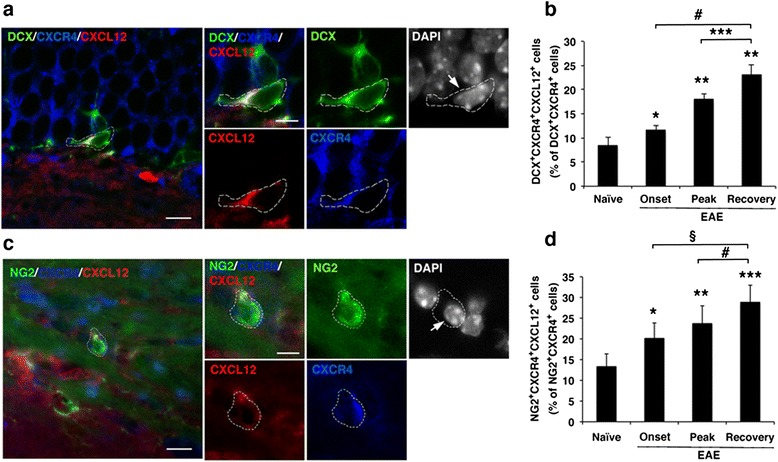Fig. 9.

The proportion of neural progenitor cells co-expressing CXCR4 and CXCL12 is elevated with the onset and progression of clinical EAE and further increased following clinical recovery. a Representative immunofluorescent image of NPC in the DG of EAE-recovered mouse co-labeled for DCX (green), CXCR4 (blue), and CXCL12 (red). Cell marked with dashed line is shown in higher magnification in the panel on the right in individual channels and merged image. b Quantitative analysis of the percentage of NPCs (DCX+) that co-express CXCR4 and CXCL12 (DCX+ CXCR4+ CXCL12+) out of DCX+ CXCR4+ NPCs in the DG of mice with indicated EAE clinical episode or following spontaneous recovery. *p = 0.01 and **p < 4 × 10−5 compared to naïve; ***p = 0.004; #p = 6.5 × 10−5. c Immunofluorescent image of OPC in the CC of EAE-recovered mice co-labeled for NG2 (green), CXCR4 (blue), and CXCL12 (red). Cell marked with dashed line is shown in higher magnification in the panel on the right in individual channels and merged image. d Quantitative analysis of the percentage of OPCs co-expressing CXCR4 and CXCL12 (NG2+ CXCR4+ CXCL12+) out of NG2+ CXCR4+ OPCs in the CC of mice with indicated EAE clinical episode or following spontaneous recovery. Percentages were determined in five consecutive sections from each mouse (n = 3). Data are mean ± SEM from two independent experiments. *p = 0.01, **p = 0.003, and ***p = 0.0002 compared to naïve; #p = 0.04 (one tail t test); §p = 0.004. Nuclei were visualized by DAPI counterstaining (white). Scale bar: a, c 10 μm; bar in right images 5 μm
